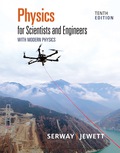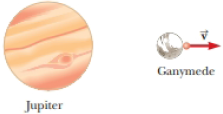
Concept explainers
Ganymede is the largest of Jupiter’s moons. Consider a rocket on the surface of Ganymede, at the point farthest from the planet (Fig. P13.23). Model the rocket as a particle. (a) Does the presence of Ganymede make Jupiter exert a larger, smaller, or same size force on the rocket compared with the force it would exert if Ganymede were not interposed? (b) Determine the escape speed for the rocket from the planet–satellite system. The radius of Ganymede is 2.64 × 106 m, and its mass is 1.495 × 1023 kg. The distance between Jupiter and Ganymede is 1.071 × 109 m, and the mass of Jupiter is 1.90 × 1027 kg. Ignore the motion of Jupiter and Ganymede as they revolve about their center of mass.
Figure P13.23

Trending nowThis is a popular solution!

Chapter 13 Solutions
EBK PHYSICS FOR SCIENTISTS AND ENGINEER
Additional Science Textbook Solutions
General, Organic, and Biological Chemistry - 4th edition
Genetics: Analysis and Principles
Campbell Biology: Concepts & Connections (9th Edition)
Fundamentals of Physics Extended
Cosmic Perspective Fundamentals
- Min Min is hanging from her spring-arms off the edge of the level. Due to the spring like nature of her arms she is bouncing up and down in simple harmonic motion with a maximum displacement from equilibrium of 0.118 m. The spring constant of Min-Min’s arms is 9560. N/m and she has a mass of 87.5 kg. What is the period at which she oscillates? Find her maximum speed. Find her speed when she is located 5.00 cm from her equilibrium position.arrow_forward(a) What magnification in multiples is produced by a 0.150 cm focal length microscope objective that is 0.160 cm from the object being viewed? 15.9 (b) What is the overall magnification in multiples if an eyepiece that produces a magnification of 7.90x is used? 126 × ×arrow_forwardGravitational Potential Energyarrow_forward
- E = кедо Xo A continuous line of charge lies along the x axis, extending from x = +x to positive infinity. The line carries positive charge with a uniform linear charge density 10. (a) What is the magnitude of the electric field at the origin? (Use the following as necessary: 10, Xo, and ke.) (b) What is the direction of the electric field at the origin? O O O O O O G -y +z ○ -z +x -x +yarrow_forwardInclude free body diagramarrow_forward2 Spring 2025 -03 PITT Calculate the acceleration of a skier heading down a 10.0° slope, assuming the coefficient of cold coast at a constant velocity. You can neglect air resistance in both parts. friction for waxed wood on wet snow fly 0.1 (b) Find the angle of the slope down which this skier Given: 9 = ? 8=10° 4=0.1arrow_forward
- dry 5. (a) When rebuilding her car's engine, a physics major must exert 300 N of force to insert a c piston into a steel cylinder. What is the normal force between the piston and cyli=030 What force would she have to exert if the steel parts were oiled? k F = 306N 2 =0.03 (arrow_forwardInclude free body diagramarrow_forwardInclude free body diagramarrow_forward
- Test 2 МК 02 5. (a) When rebuilding her car's engine, a physics major must exert 300 N of force to insert a dry = 0.03 (15 pts) piston into a steel cylinder. What is the normal force between the piston and cylinder? What force would she have to exert if the steel parts were oiled? Mk Giren F = 306N MK-0.3 UK = 0.03 NF = ?arrow_forward2. A powerful motorcycle can produce an acceleration of 3.50 m/s² while traveling at 90.0 km/h. At that speed the forces resisting motion, including friction and air resistance, total 400 N. (Air resistance is analogous to air friction. It always opposes the motion of an object.) What force does the motorcycle exert backward on the ground to produce its acceleration if the mass of the motorcycle with rider is 245 ke? a = 350 m/s 2arrow_forward2. A powerful motorcycle can produce an acceleration of 3.50 m/s² while traveling at 90.0 km/h. At that speed the forces resisting motion, including friction and air resistance, total 400 N. (Air resistance is analogous to air friction. It always opposes the motion of an object.) What force does the motorcycle exert backward on the ground to produce its acceleration if the mass of the motorcycle with rider is 245 kg? (10 pts) a = 3.50 m/s 2 distance 90 km/h = 3.50m/62 M = 245garrow_forward
 Principles of Physics: A Calculus-Based TextPhysicsISBN:9781133104261Author:Raymond A. Serway, John W. JewettPublisher:Cengage Learning
Principles of Physics: A Calculus-Based TextPhysicsISBN:9781133104261Author:Raymond A. Serway, John W. JewettPublisher:Cengage Learning University Physics Volume 1PhysicsISBN:9781938168277Author:William Moebs, Samuel J. Ling, Jeff SannyPublisher:OpenStax - Rice University
University Physics Volume 1PhysicsISBN:9781938168277Author:William Moebs, Samuel J. Ling, Jeff SannyPublisher:OpenStax - Rice University Physics for Scientists and Engineers: Foundations...PhysicsISBN:9781133939146Author:Katz, Debora M.Publisher:Cengage Learning
Physics for Scientists and Engineers: Foundations...PhysicsISBN:9781133939146Author:Katz, Debora M.Publisher:Cengage Learning Stars and GalaxiesPhysicsISBN:9781305120785Author:Michael A. Seeds, Dana BackmanPublisher:Cengage Learning
Stars and GalaxiesPhysicsISBN:9781305120785Author:Michael A. Seeds, Dana BackmanPublisher:Cengage Learning Classical Dynamics of Particles and SystemsPhysicsISBN:9780534408961Author:Stephen T. Thornton, Jerry B. MarionPublisher:Cengage Learning
Classical Dynamics of Particles and SystemsPhysicsISBN:9780534408961Author:Stephen T. Thornton, Jerry B. MarionPublisher:Cengage Learning Foundations of Astronomy (MindTap Course List)PhysicsISBN:9781337399920Author:Michael A. Seeds, Dana BackmanPublisher:Cengage Learning
Foundations of Astronomy (MindTap Course List)PhysicsISBN:9781337399920Author:Michael A. Seeds, Dana BackmanPublisher:Cengage Learning





